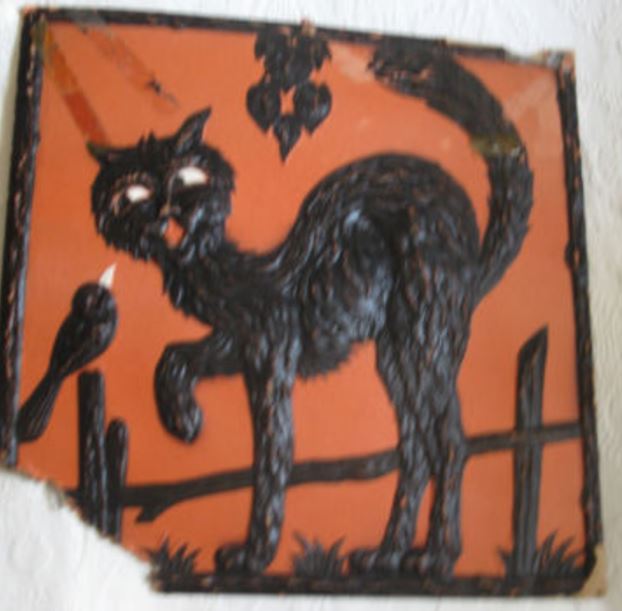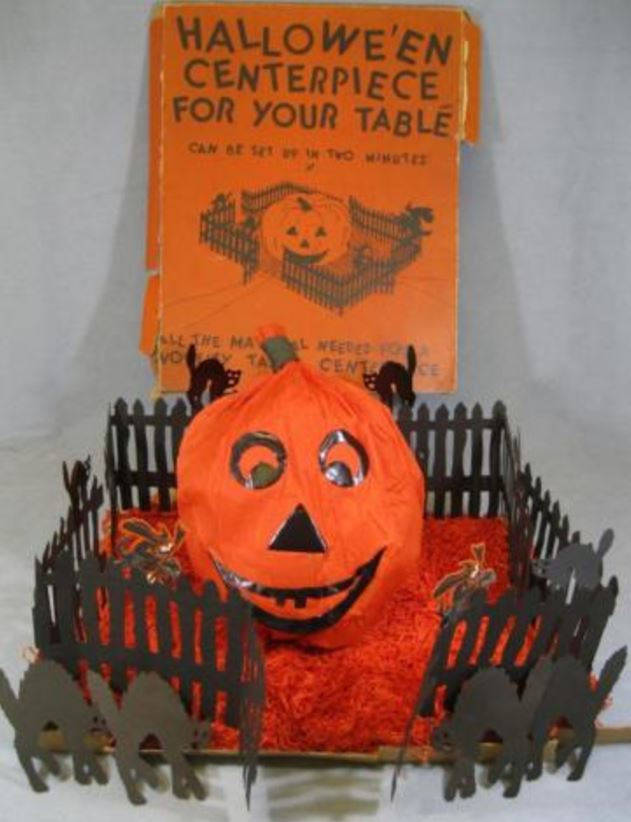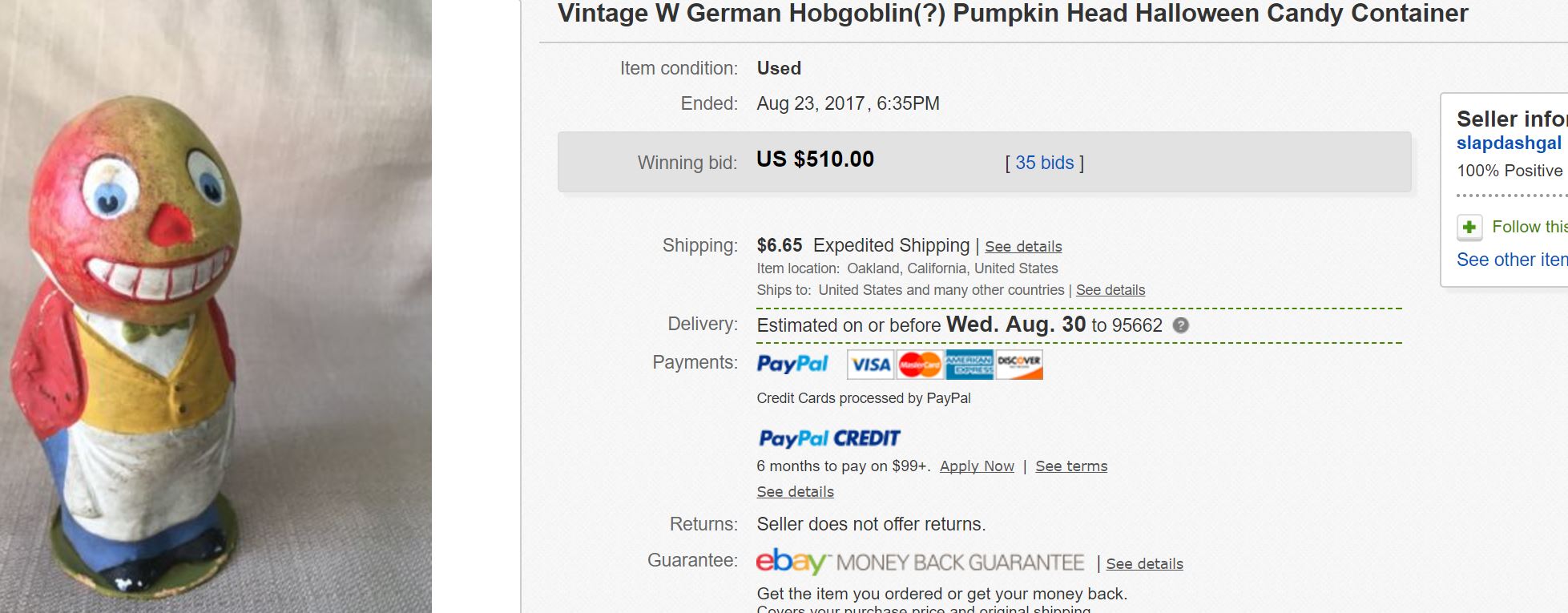The latest issue (Nov/Dec 2017) of Flea Market Decor hit the shelves today. It contains a profusely illustrated six page article on vintage Halloween collectibles. A portion from the fun interview I did with the writer is also included. Make sure you pick up a copy.
Blog
Fantastic vintage 1935 Beistle 57"" "Dangling Skeleton" with original envelope!!
This is a tough item to find in collectible condition. The seller is correct - this is a large, impressive item. The asking price is too high. SGV is $175. He has placed a "Make Offer" option to the listing, so he knows the asking price is aggressive. If you want this great item, I feel the outer edge of the pricing atmosphere is $225.
09/06 Update: Someone with a deep pocket actually paid $345 for this, surely a new record.
Halloween Two-sided Black Cat Face Lantern 1940's Old Original
I had an opportunity to chat via email with the last surviving son of the founder of Alberts Display and Novelty Company. He told me that his father, Philip Alberts, shut down the firm's operations in 1948. Their Halloween output was restricted to a period from ~1941-1946. Therefore, the dates attributed in the book to all items made by the Alberts Display and Novelty Company are slightly off. The correct date range would be ~1941-1946. Please see pages 29 and 58 where collectively three items made by the firm can be found.
The above verbiage was taken directly from my errata page. Please print a copy of this errata page and keep it with your book to ensure the information available to you while you shop or peruse is as up-to-date as can be.
VINTAGE 1920'S GERMAN HALLOWEEN SKITTLE GAME PIECES - PUMPKIN HEADED LADY
I'm glad to see these items selling so well even though they come up for sale often. I recently had an exchange with a long-time collector as to whether these items are really skittle game pieces or are simply decorative elements for a table. When I first began exploring the fun world of vintage Halloween collecting in 1988, I took my cues from dealers and collectors active in the hobby for many years preceding my involvement. Two of these folks, Paul Schofield and Mary Lou Holt, described these items the same way - as skittles. (No one ever described them differently.) Over the years, I've seen a few boxes surface for these items. These boxes do not describe them as anything other than Hallowe'en Figures. So, what is the real answer?
09/01 Update: I've received a number of meaty replies. Here is the one I like best: "The pumpkin head skittle you commented on presents another clue. The base on all three that are for sale on eBay currently have a bigger base than the usual. It has a double slot which would be for a place or name card in front I believe. That would lend credence to the table favor use. However I think this base is rather rare as I've usually seen only the narrow base with slanted sides. The narrow ones would be usable in a bowling type game. Skittles was a very popular game during this time so you can't totally discard that idea. Perhaps multiple sales ideas for the same product? Crazy how variations keep being unearthed in many of the German products. THANKS so much for your work!! It's means a lot to dealers and collectors to get this information."
Antique German Die Cut Pumpkin Jack O Lantern
Vintage RARE GERMAN WindowFrame diecut,Cat with crow on the fence,1 of 4 produc
$399.99 as the opening bid for this heavily damaged German diecut is the very definition of optimism. The seller, whose grasp on grammar, punctuation and spelling is tenuous at best, really should tamp down the optimism and simply list this remnant at $9.99 without a reserve.
09/03 Update: The seller, after no interest at her too-high opening bid price, lowered it to $39.99. That action has attracted some interest, with the price now at $79.
09/04 Update: This remnant sold for $152.50.
Vintage RARE GERMAN 3-Part Embossed Die Cut FIREPLACE SCREEN Crepe Paper Back
A small cache of these 1920s fireplace screens must recently have been unearthed, as a number have been offered for sale over the last ~6 weeks. Unfortunately, as in all such cases, the market has had some trouble absorbing them at their typical valuation of ~$2600. My advice: If you like this very large and ornate diecut, buy one today at what I consider to be bargain prices. Once these have been absorbed, the price will stabilize upward, although almost surely not at a ~$2600 level.
09/01 Update: Another one of these sold from the same seller today for $1599.99. This level seems to be the "new normal" given the number that have come on the market in the last few weeks.
Vintage 1920s Halloween Papier Mache Witch Lantern
Vintage Beistle Die-Cut Halloween Skull
The seller is spot-on. This small diecut was made by Beistle. During the early 1950s, Beistle issued a set of eight small diecuts with some unusual imagery. This is one of the eight. (All are shown on page 157.) Items from this set once surfaced more regularly than is the case today. The smoking JOL, the JOL witch and the hooded witch are more avidly sought than the others. Each typically fetches $50-60.
Large Old Antique German Germany Halloween Skeleton Vintage Embossed Decoration
RARE VINTAGE DENNISON HALLOWEEN JACKOLANTERN CAT CREPE PAPER CENTERPIECE IN BOX
I've had numerous opportunities to purchase this set for the collection and have always passed. It simply doesn't appeal to me. The box lid is the most interesting part of the whole thing! Dennison was not doing their best work in 1933, after coming off an especially creatively fertile time from 1928-1932. This sad set seems wholly uninspired.
VINTAGE RARE HALLOWEEN JOL BEISTLE DIE CUT 1940S
This diecut, produced by Beistle during the 1940s, doesn't surface as much as it once did. Part of a set that was middling in inspiration, this is a fun, memorable image. The condition of it makes me surprised that it brought as much as it did. As this poor JOL may have discovered, "Be true to your teeth or they'll be false to you."
Vintage W German Hobgoblin(?) Pumpkin Head Halloween Candy Container
I think the buyer got a solid bargain in acquiring this item. The more expensive department stores of the day, during the 1920s, carried imported holiday goods that were made with greater care, and therefore would command higher retail prices. One of the tip-offs that this remarkable candy would have been carried by The Emporium rather than, say, Kress, is the paint job. I have seen other candy containers with similar variegation. A high percentage of them still have their store tags, as having an item from such a place carried some social value at that time. So, collectors, buy candy containers that you love. If they still have their original price tags, by all means - leave them on!
VINTAGE HALLOWEEN DIE CUT 10 BLACK CARDBOARD WITCH 'S SHAPES ON A BROOM IN PKG
Be very careful in purchasing items purported to be vintage Halloween items from this seller. They have long been on my list of sellers with whom I don't do business. The sheen from the envelope is suspicious. I find it interesting there is no photo of the reverse shown and that they have not used eBay's zoom feature for this and other of their listings. If you are inclined to buy, ask lots of questions and ask for additional photos.
RARE! VINTAGE PAPER MACHE CANDY CONTAINER - CAT ON PUMPKIN BEING STUNG BY BEE
Although this candy container is uncommon, I have seen a number of them and all have a spring tail. I suspect the chenille tail is something added to it sometime after its purchase from a store.
The seller of this pleasing candy container contacted me, saying that photos of another such container show a red chenille tail. She asked if it was possible the container was made both with chenille and spring tails. Here was my reply: "Thank you so much for your email. (By the way, I very much enjoy the quality of your listings!) It is absolutely possible that the Germans made two versions, one with a chenille tail and one with a spring tail. Existing documentation on when such things were made and what original materials were used is quite incomplete. Production of goods back then was idiosyncratic, something not really true today. My guess is that if the Germans actually used chenille when completing this whimsical candy container, they used it when the supply of metal springs for such decorative purposes was low to non-existent. (This would have been the case ~1935.) A plausible unifying theory is that the earlier candy containers had spring tails and a few produced very late in the run may have been made with chenille. A discordant note about the use of chenille is the color. I would have guessed black or orange would have been used, not green and red. In the end, we’ll never really know why such decisions were made. Thanks again for your email!"














